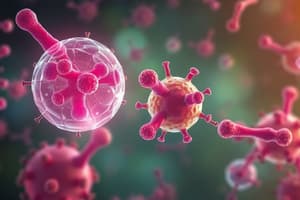Podcast
Questions and Answers
What are the components from pathogens that can act as antigens?
What are the components from pathogens that can act as antigens?
Proteins, polysaccharides, nucleic acids, lipopolysaccharide, and glycolipids
What is the role of B cells in adaptive immunity?
What is the role of B cells in adaptive immunity?
B cells primarily produce antibodies.
How do T cells contribute to the immune response?
How do T cells contribute to the immune response?
T cells can either directly attack infected targets or indirectly help other immune cells.
Why are antibodies produced by B cells useful?
Why are antibodies produced by B cells useful?
What is the process by which lymphocytes recognize and respond to specific pathogens?
What is the process by which lymphocytes recognize and respond to specific pathogens?
What plays a crucial role in maintaining immunity by providing a faster and stronger response upon subsequent exposure to a pathogen?
What plays a crucial role in maintaining immunity by providing a faster and stronger response upon subsequent exposure to a pathogen?
Flashcards are hidden until you start studying
Study Notes
Adaptive immunity is one of the two main branches of human immune systems, alongside innate immunity. It's designed to target foreign invaders like viruses and bacteria without harming cells within our body. This branch of the immune system creates specific responses tailored to particular pathogens it encounters through a process called antigen recognition.
Antigens are components from pathogens such as proteins, polysaccharides, nucleic acids, lipopolysaccharide, and glycolipids. These antigens stimulate adaptive immunity when they interact with immune cells which start the immune response. In adaptive immunity, there are specialized types of cells involved in these processes — lymphocytes being the most important ones. There are two types of lymphocytes crucial to this arm of the immune system: B cells and T cells.
B cells primarily produce antibodies while T cells can either directly attack infected targets themselves or indirectly by helping other immune cells. Antibodies produced by B cells are particularly useful because they have unique shapes that enable them to lock onto certain foreign structures present only on the surface of pathogenic organisms. Each type of pathogen has its own set of structures on their surfaces, so each requires different antibodies made specifically to fit those structures.
Immunologic memory plays another key role in maintaining immunity. When we first encounter an infectious agent, our immune system learns how to recognize it based on its structure. That recognition enables us to better respond if we come across the same pathogen again later. If you contract a virus once, your immune system will remember what that virus looks like, making subsequent infections easier to combat.
In summary, adaptive immunity relies heavily on antigens, lymphocytes (specifically B cells and T cells), the production of antibodies, and immunological memory to create targeted defenses against pathogens entering our bodies. Through these mechanisms, the human immune system remains capable of defending itself even after exposure to new threats.
Studying That Suits You
Use AI to generate personalized quizzes and flashcards to suit your learning preferences.



